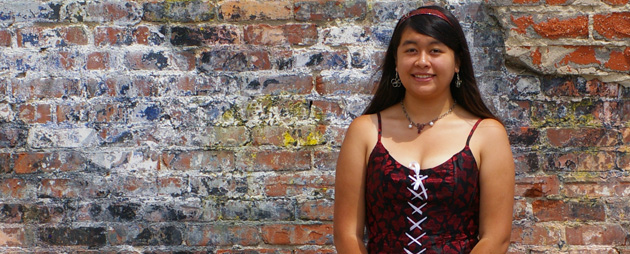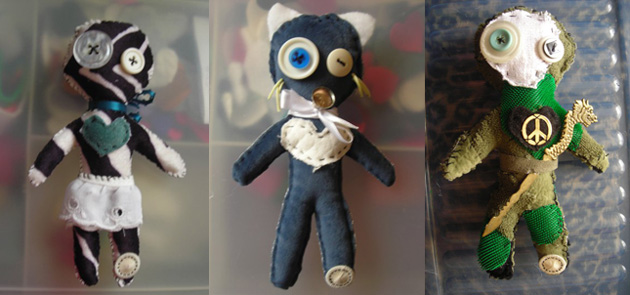
On Wednesday, April 25th, from 6 – 8 PM, the Arts Council for Long Beach will present the 2012 State of the Arts and Distinguished Arts Awards Celebration, which will be held for the first time at The Expo Art Center in Bixby Knolls. The Long Beach Unified School District is receiving the James H. Ackerman Arts Philanthropy Award. Trace Fukuhara, an artist best known for his beautiful Pacific Wind Arts & Sculpture Garden, is being presented with the Distinguished Artist of the Year award. The Distinguished Arts Leader award goes to the tireless principal of the Renaissance High School for the Arts, Mark Zahn.
A new award, for an Emerging Artist and Arts Leader, is being presented to Yoshino Rosalia Jasso who, with her mother Lisa Hernandez, founded the Long Beach Depot for Creative Reuse. Yoshino, who just turned 18 in March, is herself an artist, activist, visionary, and arts educator. I asked her how she got her start as an artist.
“I have loved art since I was a kid,” said Yoshino, “and it was therapeutic for me in Middle School. It started with my 8th grade art class. I hated it so much because the teacher made us follow her step-by-step. So I started inventing my own little ways of getting the required work done. I never followed her guidelines, and I got a C in the class.
“Fast-forward to 9th grade: My High School art teacher thought my work was strange, and involved too much thought. By then, my mom and I had our shop. Doing art at the shop kept me from throwing things at my art teacher. My creations at work came out a lot better than at school, so I guess I had a knack for it when I was given my freedom.”
I asked her what kind of work she was doing.
“On my own time,” Yoshino said, “I started out working with scrap jewelry and beads. I liked making funky charm bracelets and earrings that were too heavy to wear. After I got bored with that, I exchanged my pliers for some fabric and a sewing needle. But those projects became boring as well. I wanted to make something a little more controversial. That’s where the voodoo dolls came in.

“I was bored (that’s where most of my real inspiration comes from) and I had a book of sample textiles. The fabric pieces were too small to do anything traditional with, so I started messing around with shapes, which led to the doll pattern. I thought 2 different sized buttons would be pretty cool, and when I finished I had to show my mom. She totally freaked out and told me to start selling them. Everybody loved those dolls, creepy-looking as they were.”
Yoshino has also been conducting workshops.
“At first,” explained Yoshino, “the workshops started because I wanted to teach the neighborhood kids skills that they wouldn’t learn in school. A lot of what I do, I learned from my father. I think sewing, for example, is a very important skill for most teenagers. I was surprised at how many of my classmates were willing to pay me to fix the hems of their jeans. And there were skills I felt that both boys AND girls should know. I know that most boys don’t sign up for Home Economcs, and most girls don’t sign up for Wood Shop, at least when I was in middle school. As a teenager, it is easier for me to blur the lines that separate ‘boy’ things and ‘girl’ things.”
I asked her if she thought that gender designations have any real value.
“I don’t believe in gender rules,” Yoshino replied. “We’re all in this together, and we can’t get anything done if everyone is set on assigning jobs by gender. There were a few boys in my Home Ec class that were amazing with a sewing machine, and then there were girls who were very good with a drill.”
I asked her what art means to her.
“To me,” explained Yoshino, “art is a way of expressing what I have a hard time explaining in words. In a larger sense, I think art is a powerful weapon against every hurtful thing we as humans experience. Art can simply express a thought, feeling, or story; But it can also be the greatest resistance to oppression. It is a personal political statement and a love story.
“Graffiti is a good example of this. Gang-Tagging doesn’t count as art, at least not in the way art should be used. I like Banksy’s work. There are a lot of other graffiti artists out there. Living in Long Beach, I see something interesting on every block. I think Artist tags (stencil graffiti, yarn- bombing, seed-bombing, etc) are meant to take back our cities. These cities are our homes, and by tagging with even something as simple as a yarn-bomb, we are saying, ‘This is OUR city. We are here, and we refuse to conform the plain grey of the cement. We refuse to look like everything and everyone else. We refuse to blend in.'”
I asked her to explain ‘yarn bombing’.
“Yarn-bombing,” Yoshino said, “is a form of textile graffiti. Basically, we knit, crochet, weave, etc. small or large pieces with yarn and install them on lamp posts, trees, hand rails, and even potholes to give the area a ‘warm and fuzzy’ feeling. It makes the city a little cozier, I think.”
I asked her how art, for her, was a love story.
“There’s actually a funny story behind that,” Yoshino confessed. “My love for art has been obvious since I made that first doll. One day, my Dad and I were having a random conversation at my Aunt’s kitchen table. I had just broken up with some guy I dated in High School, and my Dad was in a fatherly mood, I guess, asking me if I’d missed the guy or had my eye on someone else. I said ‘No, I don’t have the time.’ He asked, ‘Chinita, don’t you want to get married some day?’ I don’t know where this came from, but I replied with ‘Are you kidding me? I don’t have time for boys! I’m an artist! I’m married to my art!!!’ I was 15 at the time. I guess I felt that way because art truly made me feel like I could accomplish something. My friends were cool and all, but I’m not really a people-person.”
I asked Yoshino if she found it ironic that her art has connected her to so many people.
“Yes I do,” she answered. “When people first started asking me about my art, my mom would tell me to say I got the idea from this or that. Of course I didn’t listen, and the questions I was asked would usually catch me off-guard. So I figured I might as well be honest. My honesty sometimes made my mom look at me like I was insane, but I guess some people find it charming. [laughs]”
I asked her how she felt about receiving the Distinguished Arts Award.
“This means a lot to me,” admitted Yoshino. “I never thought people would recognize my art as something cool or inspiring. When Mr. Glaza [Interim Executive Director of the ACLB] came in and told me I’d won an award, I was very surprised… in a good way. Flattered is an understatement here.”
I asked Yoshino what she saw for herself in the next several years.
“I’m guessing that the next 4 or 5 years will be spent going through school,” she explained, “balanced with more yarn-bombing and anything controversial that I can think of. I want to start a non-profit to help teens like myself claim their independence. As a teenager who ‘knows everything,’ I know that some of us do know enough to claim ourselves. High School did nothing for me, and I know I’m not the only one who’s in a hurry to change the world. I want to teach them how to graduate early, get through college, and start doing what they know they need to do. For some, that may be starting their own businesses. For others, that may be fulfilling a dream, or seeing the world before they are too old. Either way, I feel that a lot of us can be self-sufficient by 16.
“I feel that teenagers like me deserve to not only have independence, but to exercise it as well. If we can do something ourselves, there’s no use in forcing us to watch while out parents do it for us. Especially if we can do it better. Our educational system is rocky. There’s no reason to sugar-coat it. Our best teachers at this point are each other, and life experience itself.”
—
The Long Beach Depot for Creative Reuse is located at 320 Elm Avenue, and is open Monday through Saturday from 11 AM to 6 PM. To learn more about the Depot, visit TheLongBeachDepot.org.
If you’re interested in learning more about the Arts Council for Long Beach, visit ArtsLB.org. If you’re interested in attending the State of the Arts, please RSVP.
To learn about Trace Fukuhara’s Pacific Wind Arts and Sculpture Garden, visit PacificWind.org.

